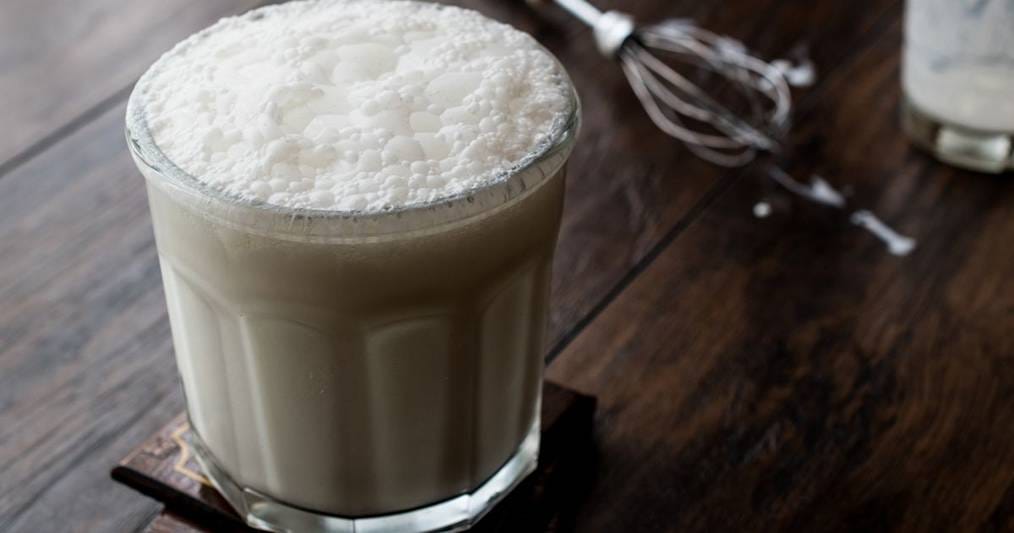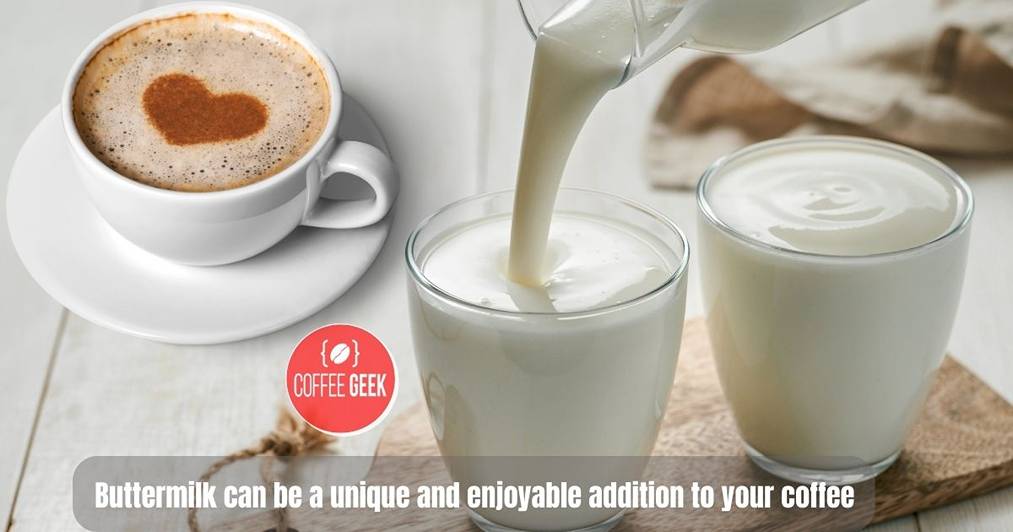Buttermilk in coffee may seem like a strange idea to some, but it has become a topic of interest for coffee enthusiasts looking for new ways to enjoy their favorite beverage.
As an alternative to regular milk or creamer, buttermilk adds a unique twist to the flavor of coffee that some may find delightful and others might not enjoy quite as much.
It’s important to understand the qualities of buttermilk and what it can bring to your coffee experience to determine if it’s worth trying in your next cup.

The history and use of buttermilk in cooking and baking can be traced back centuries, making it a familiar ingredient in the culinary world.
While it’s well-known for its benefits in enhancing flavors and textures in various dishes, the thought of adding it to coffee might seem a bit odd to some.
As a fermented milk product, drink buttermilk carries a tangy taste and is slightly thicker than regular milk, which can create a contrast in flavor when added to coffee.
Ultimately, the decision to use buttermilk is good in coffee comes down to individual preferences and a willingness to explore new taste combinations.
Key Takeaways
- Buttermilk is a unique alternative to regular milk in coffee, providing a tangy, distinctive flavor
- Coffee drinkers may appreciate buttermilk’s rich history and role in cooking and baking
- Personal taste and willingness to experiment with new flavors will determine if buttermilk in coffee is right for you
Buttermilk in Coffee

Taste Enhancement
Adding buttermilk to your coffee can enhance its taste in a unique way.
The slightly tangy flavor of buttermilk can provide a refreshing twist to your daily cup of coffee, balancing out any bitterness. While some people enjoy the sour taste, it may not be for everyone.
If you haven’t tried it before, start with a small amount to see how you like it.

Consistency and Texture
Buttermilk can add a creamier, thicker consistency to your coffee. Due to its thicker nature, it may slightly alter the mouthfeel of your beverage compared to using regular milk or cream.
The creamy texture of buttermilk can create a satisfying and pleasant drinking experience.
However, given its distinct texture, you may need to experiment to find the ideal amount that works for your personal taste.
Buttermilk Versus Other Creamers
When comparing buttermilk to other creamers, a few key differences are worth noting:
- Taste: Buttermilk has a distinct sour, tangy flavor, while other creamers like heavy cream and half-and-half are more neutral and rich in taste.
- Texture: Buttermilk is creamier and thicker than regular milk, but typically not as thick as heavy cream or some non-dairy creamers.
- Health: Buttermilk is often seen as a healthy alternative to traditional coffee creamers, as it contains fewer calories and fat compared to heavy cream or half-and-half.
Ultimately, your choice of coffee creamer is largely subjective and depends on your personal preference for taste, consistency, and health factors.

Buttermilk can be a unique and enjoyable addition to your coffee, but it’s important to experiment to find the perfect balance that suits your taste buds and nutritional needs.
What Is Buttermilk

Buttermilk is a fermented dairy product that is produced during the butter-making process.
It is a versatile ingredient often used in cooking and baking, with various health benefits.
In this section, you will learn about what buttermilk is, as well as its different types and attributes.
Traditional Buttermilk
Traditional buttermilk is the liquid left behind after churning butter from cream. It is naturally acidic due to the presence of lactic acid bacteria that ferment the milk sugars, giving it a tangy flavor.
During the fermentation process, the bacteria produce lactic acid which lowers the pH of the liquid, giving it a thicker consistency than regular milk.
Cultured Buttermilk
Unlike traditional buttermilk, which is a byproduct of the butter-making process, cultured buttermilk is intentionally produced by adding lactic acid bacteria to milk.
This process, known as culturing, accelerates the fermentation process and leads to a consistently tangy flavor and thick texture.
Cultured buttermilk is commonly found in supermarkets and is often used specifically for cooking and baking.
Buttermilk Attributes
Here are some key attributes of buttermilk:
- Consistency: Buttermilk has a thicker consistency than regular milk, making it suitable for creating rich and creamy textures in recipes.
- Acidity: The lactic acid produced during the fermentation process gives buttermilk its characteristic tangy flavor and acidity. This acidity can also serve as a natural leavening agent in baked goods.
- Nutritional profile: Buttermilk is typically lower in fat and calories than regular milk, while still providing a good source of vitamins and minerals such as calcium, phosphorus, and potassium.
- Probiotic benefits: Due to the presence of lactic acid bacteria, buttermilk is considered a probiotic food that can support digestive health and strengthen your immune system.
Now that you have learned about buttermilk, its different types, and its attributes, you can better understand how it might enhance the flavor and texture of your coffee when added to it.
Health Benefits of Buttermilk

Nutritional Profile
Buttermilk has a unique nutritional profile which includes essential nutrients such as calcium, phosphorus, and various vitamins and minerals. It also contains a good amount of protein.
The fermentation process increases its probiotic content, making it beneficial for gut health.
Digestive Advantages
The presence of probiotics in buttermilk aids in digestion and gut health.
These probiotics transform lactose into lactic acid, making it more tolerable for those with lactose sensitivities.
Incorporating buttermilk into your coffee can improve your overall digestive health and well-being.
Lower Fat and Caloric Content
Compared to regular milk and cream, buttermilk has a lower fat content and caloric content, making it a healthier alternative for your coffee.
By replacing regular milk or cream with buttermilk, you can enjoy a delicious cup of coffee with fewer calories and less fat, while also reaping the additional health benefits associated with it.
Buttermilk’s Role in Baking and Cooking

Baking Benefits
Buttermilk is an excellent ingredient to incorporate into your baking recipes. You might have noticed it’s commonly used in biscuits, cakes, and other baked goods.
The acidity of buttermilk, when combined with baking soda, works as a natural leavening agent, allowing for a fluffier and lighter texture in your recipes.
Additionally, it helps to lock in moisture, ensuring your cakes remain deliciously moist and tender.
Here are some common uses of buttermilk in baking:
- Biscuits: Buttermilk provides a tender crumb and distinctive flavor.
- Cakes: The acidity of buttermilk creates a moist and tender cake crumb, as well as enhancing other flavors.
Cooking With Buttermilk
Beyond its role in baking, buttermilk plays a part in many cooking recipes as well. Its tangy taste can add depth of flavor to salad dressings and marinades.
The acid in buttermilk also acts as a tenderizing agent, making it a perfect addition to meat marinades.
Moreover, it can provide a unique and enjoyable twist to your regular dressings for salads or dips.
A few delicious recipes to consider when incorporating buttermilk include:
- Buttermilk Ranch Dressing: Enhance the creaminess and tanginess of your favorite ranch dressing.
- Fried Chicken Marinade: With buttermilk’s tenderizing properties, you can ensure juicy and tender fried chicken.
- Creamy Buttermilk Coleslaw: Add a creamy and tangy twist to your classic coleslaw recipe.
By adding buttermilk to your baking and cooking recipes, you can experience an array of flavors and textures that will elevate your dishes to new heights.
Comparing Milk Varieties in Coffee

Flavor Comparisons
When it comes to flavor, buttermilk is known for its sour taste, which may not complement coffee well. In contrast, whole milk offers a creamy and more pleasant flavor to your beverage.
Almond milk and cashew milk provide slightly sweet and nutty tastes, while oat milk and soy milk bring mild, neutral flavors.
If you prefer a tropical twist, coconut milk adds a subtle hint of coconut to your coffee.
Rice milk and hemp milk also have subtle, sweet flavors, but their thinner consistencies may affect your coffee’s overall taste.
Texture and Consistency
The consistency of your coffee can be greatly impacted by your choice of milk.
Buttermilk has a thicker consistency than regular milk, which may lead to a heavy mouthfeel when mixed with coffee.
Whole milk is creamy, making it a popular choice for a smooth coffee texture.
On the other hand, non-dairy alternatives like oat milk and soy milk can still provide creamy textures, but may be slightly thinner.
Cashew milk and almond milk are known to have similar thickness to whole milk.
Coconut milk and rice milk are thinner options, while hemp milk offers a more cream-like consistency.
Nutritional Differences
The nutritional values of milk alternatives can also affect your coffee experience.
Traditional dairy options, like whole milk, contain lactose, making them unsuitable for those who are lactose-intolerant.
Buttermilk has fewer calories and fat than whole milk but comes with a more acidic profile.
For lactose-free choices, almond milk, oat milk, and soy milk all offer high protein and fiber content.
If you’re looking for a source of Omega fatty acids, coconut milk, flaxseed milk, and hemp milk can meet your needs.
For a sweeter alternative, cashew milk offers a creamy texture with lower calories.
In conclusion, the type of milk you choose for your coffee can greatly impact its flavor, texture, and nutritional value.
It is essential to consider your taste preferences, dietary needs, and desired coffee experience when selecting a milk variety.
Preparing Buttermilk Coffee

Recipes and Proportions
To create the perfect buttermilk coffee, it is essential to understand the proportions and ingredients.
Here are some examples of how to incorporate buttermilk into different coffee beverages:
- Classic Buttermilk Coffee: Add 1 part buttermilk to 3 parts hot coffee for a creamy and slightly tangy drink.
- Cold Brew Buttermilk Coffee: Combine 1 part buttermilk with 4 parts cold brew coffee for a refreshing and flavorful alternative to iced coffee.
- Buttermilk Cappuccino: Mix 1 part buttermilk with steamed milk and add to a double espresso shot, then top it off with frothy milk foam for a silky textured delight.
- Buttermilk Latte: Combine 1 part buttermilk with 3 parts steamed milk and pour over a double espresso shot to create a creamy, smooth, and tangy beverage.
Remember to adjust these proportions to your taste preferences.
Techniques for Best Results
Achieving the best results in your buttermilk coffee requires some techniques to ensure a silky texture and balanced flavors.
Follow these recommendations:
- Warm the buttermilk: To avoid curdling, gently heat the buttermilk before adding it to hot coffee or espresso. Warming it to just below boiling (around 86°F or 30°C) helps incorporate the buttermilk smoothly.
- Whisk for a frothy texture: Enhance the texture of your buttermilk coffee by using a whisk, handheld frother, or steam wand to create a frothy, light consistency.
- Sweeten if desired: Some may find the tangy flavor of buttermilk slightly too intense. Feel free to add a sweetener of your choice, such as honey, agave syrup, or sugar, to balance out the flavors.
- Experiment with different coffee types: While buttermilk can complement most coffee variations, trying different roasts, origins, and strengths might help to find the perfect blend for your palate.
With these tips and recipes, you can enjoy creating delicious, unique buttermilk coffee beverages in the comfort of your own home.
| Pros | Cons |
|---|---|
| Creamy texture | Unconventional flavor |
| Adds richness to the coffee | May separate if not mixed well |
| Can be a lower-calorie alternative to cream | May not suit everyone’s taste preferences |
| Adds a unique tanginess to the coffee | Potential for curdling in hot coffee |
| May provide some additional nutrients | May alter the acidity of the coffee |
Final Words
The concept of adding buttermilk to coffee might seem unconventional to many coffee enthusiasts.
The taste of buttermilk, known for its sour tang, can be a unique and surprising addition to your morning cup of coffee.
While buttermilk can be used in various recipes, its incorporation into coffee isn’t a common practice and isn’t worth the try for everyone.
For those adventurous enough to experiment, buttermilk can help add a distinct flavor to your coffee drink, transforming it into something beyond the regular coffee routine.
The combination of buttermilk and coffee offers a contrast between the bitterness of coffee and the sour taste of buttermilk.
This can make your coffee taste more complex and can be a delightful addition for those who enjoy experimenting with different textures in their coffee.
However, it’s important to consider the consistency of the buttermilk, as it is thicker than regular milk and can alter the texture of the coffee.
For those interested in trying buttermilk in their coffee, a buttermilk cinnamon latte could be a good recipe to try.
It blends the spiciness of cinnamon with the tanginess of buttermilk, adding a unique spin to the flavor of the coffee.
However, it’s crucial to remember that buttermilk will curdle and turn when added to hot coffee, so it’s best used in cold coffee drinks.
Buttermilk can also be used as a healthier alternative to regular milk in their coffee since it is low in calories and can help with digestion.
However, for those who in coffee don’t like buttermilk, regular milk is a good option, or you could put lemon juice or vinegar in milk as a substitute known as buttermilk.
In conclusion, using buttermilk in coffee is an acquired taste and might not suit everyone. It’s a matter of personal preference, and for those who are curious, it’s worth trying buttermilk in your coffee to see if it aligns with your taste buds.
Buttermilk can be a healthy addition to your diet, and incorporating it into coffee could be an interesting way to introduce new flavors and textures to your coffee experience.
Frequently Asked Questions

Can I put buttermilk in my coffee instead of regular milk?
Yes, you can use coffee and buttermilk instead of regular milk. It gives a slightly tart taste which can complement the flavors of your favorite coffee beans.
However, the taste might not be for everyone and some people may feel that buttermilk in coffee isn’t worth it.
How does coffee taste when I use buttermilk instead of regular milk?
When you use buttermilk, it can alter the taste. Buttermilk imparts a tangy, rich flavor which might enhance or contrast with the taste of the coffee.
It’s a different experience compared to using regular milk or creamer, and it’s definitely worth a try.
Is putting buttermilk in coffee a popular addition?
AThe use of buttermilk in coffee isn’t very common. Most people drink coffee with regular milk, cream, or specialty coffee creamers.
However, buttermilk can be a unique and interesting addition to coffee for those looking to experiment with flavors.
Is it good to drink buttermilk in coffee for health reasons?
Yes, drinking buttermilk in coffee can have health benefits because buttermilk is low in calories and fats compared to traditional coffee creamers.
Including buttermilk in your diet, even in coffee, can provide probiotics and other nutritional benefits.
How do I add buttermilk to my coffee?
Buttermilk you can add to your coffee just like you would with regular milk or creamer. Start off by adding a small amount, then adjust according to your taste preferences.
Make sure to try adding buttermilk to different coffee recipes for a unique flavor profile.
Any specific coffee recipes where I should try using buttermilk?
For coffee recipes, you could try the buttermilk cinnamon latte. It includes a buttermilk taste, cinnamon, and your choice of coffee.
The tang of buttermilk contrasted with the sweetness of cinnamon makes for an interesting flavor combination.
Can I put buttermilk in tea just like in coffee?
Sure, you can put buttermilk in tea. Much like coffee, the taste will be tangy and rich which may provide a unique flavor to your regular tea. It could be an interesting variation to try.
Are there any substitutes I can use instead of buttermilk in coffee?
If you’re not keen on the taste of buttermilk, you can opt for alternatives like almond milk, coconut milk, or oat milk for a different flavor profile.
Depending on your preference, these can also provide a creamier texture to your coffee.
How does buttermilk compare to other milk alternatives in coffee?
When you use buttermilk instead of other milk alternatives, the flavor of your coffee is likely to be tangier due to the acidity of buttermilk.
It may also give your coffee a creamier consistency. But, the preference depends on individual taste.
Can I use coffee instead of milk in buttermilk?
Typically, coffee is not used as a replacement for milk in buttermilk. However, if you’re experimenting with flavors, you could try it out.
The strong flavor of coffee will likely dominate the flavor profile, but it could lead to an interesting outcome.

